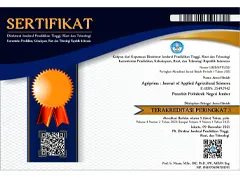Author Guidelines
Agriprima is a peer reviewed journal that is published twice a year, in March and September. The number of articles in each volume is 9-10 articles. The article is the result of research in the field of agriculture that has never been published in any journals, written in Indonesian or English.
To be successful in the submission process, please refer to the following points:
- Read the Aims & Scope for an overview and assess whether your manuscript is suitable for this journal
- Use the Journal Template to prepare your manuscript.
- Ensure that issues of publication ethics, research ethics, copyright, authorship, image formats, data formats and references are clearly understood.
- Make sure all authors have approved the contents of the submitted manuscript
Manuscript Preparation
Manuscript file
All manuscript files should be prepared in an editable file using an appropriate word processing package and saved as .docx or .rtf, pay attention : manuscript files with a PDF (.pdf) extension are not acceptable file types. The manuscript is written in A4 paper using Times New Roman font, size 12, one single space.
Use a journal template
Agriprima journal has provided a journal template and a guide using the template below. As for the templates that have available writing styles / designs, we recommend using versions of Microsoft Word 2010 and above to ensure that the design / writing styles work well
Download TemplateManuscript Languages
Agriprima journal accepts articles in Indonesian and in English, make sure the use of words, phrases, sentences is in accordance with the General Guidelines for Indonesian Spelling (PUEBI) and American English Grammar for article in English language
Article Structure
Based on Agriprima journal template article structure must be sequential and contain according to the following conditions:
Title
The title should be short, clear, and informatively describing the content of the research paper. Avoid writing abbreviations and non-standard terms in the title.
Author(s)
The author's name is written in full name of each author (not include academic degrees), address(es) of the institution(s) at which the work was performed, and each author’s affiliation. Affiliation is written with the name of the department/divisions followed by the name of the university/institution. Where there is more than one affiliation, match authors and their appropriate affiliations with superscript numbers (avoid asterisks). Use a superscript asterisk to mark the author to whom correspondence should be directed.
Abstract
Abstract contains a brief research background, objectives, methods, significant results, and conclusions. Avoid specialized terms, abbreviations, diagrams, and references. Contains a maximum of 250 words.
Keywords
A list of keywords may also be included on the title page. It contains a maximum of 5 keywords which can be single words/phrases. Keywords are sorted alphabetically and separated by comma (,).
1. Introduction
The introduction contains the background or main problems and research objectives which are supported by the latest results as a basis for reference. Prioritized journal, proceedings, thesis, or dissertation as references, no longer than 1000 words.
2. Method
The method is an explanation of the experimental design and the parameters of the research observation. Methods should be brief (no more than 600 words) but detailed enough to allow repetition of work by other qualified researchers. Details procedures should be written by referring to the original procedure description or related modifications published. Clearly describe the method and specification of the equipment types/material used such as chemicals, microbial strains, plant species, mutants, etc. Do not use sub-chapter headings for each section in the method. The unit of measure is written according to the international system.
3. Result And Discussion
The section should describe the results of the experiments and provide an interpretation of the results in relation to previously published work. The references used are the primary reference with more than 80% priority. Present the results as concisely as possible in one of the following: text, figure(s), or active table(s) that can be edited by the editor. Number figures and tables according to the order of citation in the text.
4. Conclusion
It must answer the research objectives which is a summary of the research findings. Conclusions should be presented briefly, and clearly based on the results and discussion of the research.
5. Acknowledgements (Optional)
Contains gratitude to individuals or institutions who contributed to the research or provide funds for conducting research, written in paragraphs.
6. References
It is required to use a new reference source for at least the last 5 years, and 80% comes from the primary reference. References are sorted according to the alphabet, following the American Psychological Association (APA) format. Preferably using the Mendeley App or EndNote and adding the DOI or online pdf link
Learn the complete guide on how to write references using APA Style
Artwork
1. Electronic artwork
General points
- Make sure you use uniform lettering and sizing of your original artwork.
- Embed the used fonts if the application provides that option.
- Aim to use the following fonts in your illustrations: Arial, Courier, Times New Roman, Symbol, or use fonts that look similar.
- Number the illustrations according to their sequence in the text.
- Use a logical naming convention for your artwork files.
- Provide captions to illustrations separately.
- Size the illustrations close to the desired dimensions of the published version.
- Submit each illustration as a separate file.
- Ensure that color images are accessible to all, including those with impaired color vision.
Formats
If your electronic artwork is created in a Microsoft Office application (Word, PowerPoint, Excel) then please supply 'as is' in the native document format. Regardless of the application used other than Microsoft Office, when your electronic artwork is finalized, please 'Save as' or convert the images to one of the following formats (note the resolution requirements for line drawings, halftones, and line/halftone combinations given below):
- EPS (or PDF): Vector drawings, embed all used fonts.
- TIFF (or JPEG): Color or grayscale photographs (halftones), keep to a minimum of 300 dpi.
- TIFF (or JPEG): Bitmapped (pure black & white pixels) line drawings, keep to a minimum of 1000 dpi.
- TIFF (or JPEG): Combinations bitmapped line/half-tone (color or grayscale), keep to a minimum of 500 dpi.
Please do not:
- Supply files that are optimized for screen use (e.g., GIF, BMP, PICT, WPG); these typically have a low number of pixels and limited set of colors
- Supply files that are too low in resolution
- Submit graphics that are disproportionately large for the content.
2. Color artwork
Please make sure that artwork files are in an acceptable format (TIFF (or JPEG), EPS (or PDF), or MS Office files) and with the correct resolution. If, together with your accepted article, you submit usable color figures then Elsevier will ensure, at no additional charge, that these figures will appear in color online (e.g., ScienceDirect and other sites) regardless of whether or not these illustrations are reproduced in color in the printed version.
3. Figure captions
Ensure that each illustration has a caption. Supply captions separately, not attached to the figure. A caption should comprise a brief title (not on the figure itself) and a description of the illustration. Keep text in the illustrations themselves to a minimum but explain all symbols and abbreviations used.
4. Tables & Graphs
Please submit tables / graphs as editable text and not as images. Tables / can be graphs placed either next to the relevant text in the article, or on separate page(s) at the end. Number tables consecutively in accordance with their appearance in the text and place any table notes below the table body. Be sparing in the use of tables and ensure that the data presented in them do not duplicate results described elsewhere in the article. Please avoid using vertical rules and shading in table cells.
Publication Stages
1. Submitted Stage
Authors can send submissions online when they already have an account on this website, at this early stage notification of submissions will be immediately received by the editorial board, therefore make sure:
- The manuscripts that will be sent are in accordance with the provisions of this journal
- Complete the submission metadata on the form provided on the website
- If there are problems during the delivery process, please contact our support office
2. Pra-Review Stage
In this second stage, the manuscript submitted by the author will be processed by the editor, as for the pre-review conditions as follows:
- Editors who process the manuscripts are selected by the editorial board based on the suitability of the editorial scientific field with the script being processed
- The time required for processing is at least 2 week after the manuscript is received by the editorial board
- Some that are reviewed by the editor at this stage are:
- Does the manuscript match the Aims & scope of this journal? If not, the submission will be rejected immediately
- Does the manuscript match this journal template? If not, the submission will be returned for revision by the author
- Has the manuscript passed the plagiarism check in accordance with the provisions in this journal? If not, the submission will be returned for revision by the author
- The deadline for revision at this stage is a maximum of 2 weeks, and will be rejected if it exceeds the deadline
- The editor will continue to the next stage if the above criteria have passed
3. Reviewing Stage
The quality of the publication is determined at this stage, the editor will send a request to the reviewer to review the manuscript, as for the following conditions:
- Reviewers are selected by editors based on the suitability of the scientific field, at least 2 reviewers
- Reviewers are given a deadline of 2 weeks to respond to editor requests and 4 weeks to complete the review of manuscript
- The editor together with the reviewers will review the manuscript using the single blind review method
- Some that were reviewed by peer groups at this stage are presented in full in the peer-review policy
- After the review process is complete, the editor will make a decision on the manuscript based on the recommendations from the reviewers
- If a minor revision is required: The manuscript will be returned to the author for revision with a deadline of 2 weeks, then the editor will proceed to the next stage after the manuscript is revised
- If a major revision is required: The manuscript will be returned to the author for revision with a deadline of 2 weeks, then the peer groups will review it again in the second round (back to point 3.b)
- The editor will take a decision to accepted if the above criteria have been exceeded, A notification that the article is accepted and can be published is sent along with the author's fee bill
- After the fees are paid, the editor will proceed to the next stage
4. Editing Stage
The work at this stage is mostly done by the editor. In general, at this stage the author(s) is just waiting for the article publishing schedule, a communication between author(s) and editor if needed. This work at least takes 2 weeks
- Copyediting
The editor will check each manuscript and edit it if necessary, any changes made by the editor to the manuscript will be notified to the author(s) to approve the changes. Checks that will be carried out is:
- The words uses, sentences and grammar of the manuscript
- Typing errors, and ensuring all information contained in figures, tables and graphs is clear
- Reference style, and ensuring all DOI or URL listed on the reference is searchable
- Plagiarism check is carried out in the next process, pay attention to the plagiarism policy
- Editing Layout
The editor will convert the manuscript to a PDF format file according to this journal layout template, provides page numbering, DOI, Copyright, license information, etc.
- Scheduling Publication
As an author(s), he must be wise and be able to calculate the time needed to publish his work in this journal, the manuscript that has passed the publication stage will be scheduled for publication immediately, as an illustration of how the editor schedules publication as follows:
- Each issue is published in the last week of the scheduled month (March & September) and contains 10 acticles every issues
- The list of articles to be published in the issue at least has passed the publication stage a maximum of 1 week before the issue's publication schedule
- When the current issue publication schedule and 10 articles have been filled, the articles that have passed the publication stage will be scheduled for the next issue publication schedule.
5. Indexing Stage
Agriprima is a journal with an open access policy, all articles published immediately can be read and downloaded for free to the public, therefore to increase the dissemination and visibility of publications once the article is published it will be indexed automatically, see our indexer list. Based on copyright and license policies, authors can redistribute publications in institutional repositories / social media / personal websites / other indexing engines provided that the Agriprima Journal is listed as the first publication.









